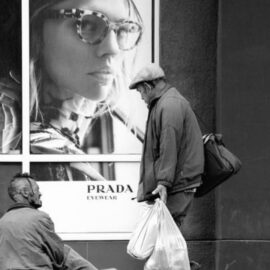

This article is an excerpt from the Shortform book guide to "Black Like Me" by John Howard Griffin. Shortform has the world's best summaries and analyses of books you should be reading.
Like this article? Sign up for a free trial here.
What are the historic challenges to ending systemic racism in the U.S.? How did systemic racism operate in the Deep South?
In his book Black Like Me, John Howard Griffin documented the racism Black Southerners experienced in the 1950s in the U.S. According to him, there were three primary challenges to ending systemic racism in the Deep South.
Read on for an overview of the historic challenges to ending systemic racism in the U.S., according to Griffin.
Challenges to Ending Systemic Racism
During his time in the Deep South, journalist John Howard Griffin didn’t only witness acts of individual racism and Black people’s responses to them. He argues that the racism Black people experienced was systemic: It was a network of racist policies that limited their rights and opportunities. He noticed examples of systemic racism in areas such as employment, politics, education, and justice. In this article, we’ll outline three main challenges that Griffin claims are barriers to ending systemic racism in the South.
(Shortform note: Although Griffin doesn’t use the term “systemic racism” in his book, we use it here because Griffin’s description of Southern racism aligns with definitions of this modern phrase. For instance, in So You Want to Talk About Race, Ijeoma Oluo describes systemic racism as power structures that reinforce racial prejudice. Like Griffin’s description of Southern networks of racist policies, Oluo’s definition emphasizes that systemic racism encompasses laws and rules that marginalize racial minorities.)
#1: Racial Oppression Sowed Divisions Among Black Southerners
Griffin claims that racism turned Black Southerners against each other, preventing them from forming a united front against ending systemic racism. Let’s explore which of Griffin’s experiences led him to this conclusion.
First, Griffin’s conversations with several Black Southerners revealed to him this lack of Black unity. For instance, a Black cafe owner expressed to Griffin that Black people sometimes competed with each other for white approval. The cafe owner explained that there was a social hierarchy among Black people: Some darker-skinned Black people idolized light-skinned Black people because they were closer to whiteness, and some light-skinned Black people gained a sense of superiority from this treatment. Griffin and the cafe owner agreed that these interactions prevented Black people from identifying their common struggle and fighting together against ending systemic racism.
(Shortform note: Today, people sometimes use the term “scarcity mentality” to describe the competitive mindset that people with marginalized identities often develop. When you have a scarcity mentality, you believe that there’s a finite amount of resources (such as money or approval) and that you must compete with others to get enough of these resources. Some experts claim that as capitalism arose in the 17th century, leaders with economic power forced a scarcity mentality upon oppressed groups. They created divisions among lower classes, such as the divisions between dark- and light-skinned Black people, so that these groups would focus on competing with each other for resources rather than working together to topple the power structure.)
Second, Griffin clarifies that this lack of unity among Black people existed because they were oppressed—not because they were inherently uncooperative. Specifically, oppression caused them to treat other Black people as inferior. Griffin reasons that some were uncomfortable with their own Blackness, so they took out their discomfort on other Black people by belittling them.
| What Is Colorism, and What Can We Do About It? The phenomenon that the cafe owner describes to Griffin is an example of colorism (a term coined by novelist Alice Walker in the 1980s). As Ibram X. Kendi explains in How to Be an Antiracist, colorism is a form of prejudice or discrimination that typically favors people with lighter skin over those with darker skin. Kendi traces colorism back to the 17th century when slaveholders perpetuated the idea that light-skinned enslaved people were closer to the “ideal” of whiteness. These enslavers assigned lighter-skinned Black people skilled labor rather than the physically demanding work they assigned to darker-skinned Black people. Modern scholars’ ideas on colorism support Griffin’s observation that colorism creates divisions within Black communities. Research on internalized oppression illuminates how colorism sows divisions. Internalized oppression is when marginalized groups believe the stereotypes that oppress them, such as colorist stereotypes. According to psychologists, when members of a marginalized group don’t have the opportunity to direct their frustration at the source of their oppression, they direct their frustration toward themselves or toward those who share their identities. Griffin observed internalized oppression in action when he noticed Southerners taking out their internalized discomfort with their own Blackness on other Black people. Furthermore, scholars share Griffin’s view that these divisions within marginalized groups aren’t the fault of those groups. Rather, those with more power are at fault because they maintain oppressive structures (such as racism, economic inequality, and sexism). This is why some argue that it’s white people’s responsibility to end white supremacy—since white people created racist ideas and hold more political and social power to end systemic racism. Although oppressed groups aren’t responsible for creating the forms of oppression that marginalize them (such as colorism), some argue that oppressed groups still have a responsibility to resist internalized oppression when they encounter it within their communities. One writer argues that Black people can do this by identifying instances of colorism within their communities, tracing these prejudices back to their roots in early racism, and openly discussing how to stop spreading these harmful beliefs. |
#2: Barriers Exist Between Black and White Southerners
While on his journey, Griffin not only noticed divisions among Black Southerners, but he also noticed divisions between Black and white Southerners who shared a commitment to advancing Black civil rights. Griffin argues that communication barriers and misunderstandings between Black and white antiracists bred mistrust and stymied racial progress. Let’s further explore two of these barriers.
Barrier 1: White Activists Excluded Black Activists
First, Griffin claims that many white civil rights activists failed to include Black people in their discussions and plans towards ending systemic racism, which reduced Black people’s trust in white activists. Black people interpreted their exclusion as evidence that white people didn’t value Black people’s ideas. This deepened their distrust of white activists’ intentions and efforts.
(Shortform note: Today, people sometimes refer to white racial justice activists’ exclusion of non-white activists as a symptom of a “white savior complex.” This is when a white person attempts to rescue people of color (POC) from oppression. This behavior is often rooted in white people’s belief that they know what’s best for POC. White saviorism is problematic because it patronizes POC and reduces their autonomy. Some claim that instead of being saviors, white people seeking to be antiracist should instead be white co-conspirators: supporters who follow the lead of POC fighting racism. For example, white co-conspirators fundraise for POC-led groups, amplify the stories and opinions of POC, and advocate for antiracist policies.)
Barrier 2: White People Felt Defensive
Second, Griffin argues that white people who saw themselves as antiracist often became offended and frustrated when Black people expressed distrust toward them. Additionally, white people got angry when they felt that Black people weren’t grateful for their support.
(Shortform note: Griffin’s claims about white defensiveness align with Robin DiAngelo’s idea of white fragility (which she explores in her book, White Fragility). According to DiAngelo, white fragility is when white people become frustrated or defensive when they’re accused of being racist. She explains that white people often have this reaction because they interpret these accusations as claims that they’re “bad people.” DiAngelo argues that this interpretation reflects a misunderstanding of how racism works. Racism isn’t just the sum of individual racists’ actions: It’s a system of racist policies that marginalize racial minorities. Therefore, even if you consider yourself a “good person,” you may still be complicit in racism and responsible for fighting it.)
#3: Oppression Was Hard to Escape
Finally, Griffin claims that the systemic racism Black Southerners faced made it hard for them to escape oppression. Systemic racism deprived Black Southerners of opportunities and resources to advance their rights. When they resisted this racism, they were persecuted for doing so. In this section, we’ll explore four factors that contributed to this cycle of oppression.
Factor 1: Black People Faced Barriers to Economic Mobility
Griffin argues that Black Southerners faced barriers to overcoming poverty for two main reasons. First, Black Southerners lacked job opportunities due to their lack of education as well as discriminatory hiring practices. Griffin experienced this barrier while disguised as a Black man: In his six weeks in the Deep South, he searched relentlessly for work but employers (who were usually white) repeatedly turned him down.
(Shortform note: Historians add that even when Black Southerners found jobs, those jobs paid poorly due to Jim Crow laws. White leaders separated white and Black workers by ensuring white workers had access to well-paying jobs and Black workers could only access low-paying work, such as factory jobs and roles as domestic workers.)
Second, Griffin claims that Black people faced barriers to economic mobility because debt kept Black families in poverty. Several Black men Griffin formed friendships with lamented that very few jobs available to them paid them enough to support their families. This plunged them into debt that was nearly impossible to escape. According to Griffin, white men intentionally kept Black men in debt to ensure they’d remain below them on the social ladder.
(Shortform note: Historians corroborate Griffin’s claim that white people used debt to keep Black families poor. For example, many Black farming families in the South inherited debt from previous generations. Following the Civil War, most newly-freed Black farmers could only find jobs working as sharecroppers on white-owned farms (an arrangement in which Black farmers paid a portion of their crops as rent for using the land). These Black farmers had to take out loans from the landowners to pay for their farming materials, and they often went into debt because white landowners underpaid them and charged them high interest rates. These Black farmers’ children inherited this debt, starting a cycle of intergenerational debt.)
Factor 2: Black People Faced an Unjust Justice System
Second, Griffin claims that Southern criminal justice failed to protect Black citizens. Griffin observed Black people’s frustration with the unfairness of Southern justice following the recent lynching of Mack Charles Parker, a young Black man from Mississippi. After Parker was accused of raping a white woman, a mob of white men kidnapped and lynched him—and the men in this mob were never indicted for murder. Black people expressed to Griffin that this case was evidence of an unjust system that favored white people.
(Shortform note: Following the police killings of George Floyd, Breonna Taylor, and others, many experts have drawn parallels between these murders and the justice systems that failed to protect Southern Black citizens from lynch mobs in the past. For instance, over 60 experts on UN rights recently issued a statement calling on the U.S. to address instances of racist police brutality, claiming that these acts are modern-day lynchings.)
Factor 3: Racial Justice Efforts Were Suppressed
Third, Griffin argues that many efforts to advance Black people’s civil rights were suppressed. Several Black people shared with Griffin that when people (of any race) tried to fight for racial justice, they were accused of being “anti-American.” When civil rights activists traveled the country to give talks on anti-racism, they were often followed and harassed.
(Shortform note: In Stamped From the Beginning, Ibram X. Kendi clarifies some of the historical events that set the stage for these accusations and efforts to stamp out antiracist activism. In 1950, Wisconsin senator Joseph McCarthy launched what people now call the Second Red Scare. This effort aimed to rid the U.S. of Communist ideas and those who espoused them, out of fear that these people sided with the Soviets in the Cold War. This period led to paranoia and skepticism surrounding anyone who was considered remotely anti-American, including antiracist activists who criticized Southern segregation laws. Many antiracists were harassed, fired, threatened, and arrested under the pretense that they were anti-American communists.)
Griffin elaborates that efforts to suppress antiracist resistance perpetuated the myth that racism didn’t exist. He explains that Black people were caught in a double bind: If they spoke up about racism, they were criticized or harassed for being “anti-American.” If they didn’t speak up, people wouldn’t hear their experiences of racism. Either way, Black people were silenced and other Americans continued believing the myth that racism didn’t exist.

———End of Preview———
Like what you just read? Read the rest of the world's best book summary and analysis of John Howard Griffin's "Black Like Me" at Shortform.
Here's what you'll find in our full Black Like Me summary:
- The 1959 story of a white man who spent six weeks living as a Black man
- The brutal racism Black southerners faced in the mid-1900s
- Griffin’s insights about hope for racial progress in the South






